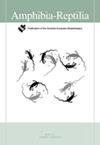留尼汪岛特有的一种极度濒危的树栖日壁虎的微生境利用和运动的年内变化:对保护的影响
IF 1.3
4区 生物学
Q3 ZOOLOGY
引用次数: 2
摘要
栖息地的丧失是爬行动物数量减少的主要原因,因此,栖息地研究对实施保护行动至关重要。我们调查了马纳帕尼日壁虎(Phelsuma expectata)的微栖息地使用情况,这是留尼汪岛(西印度洋)特有的一种极度濒危物种。人为干扰导致壁虎种群严重分裂,对该物种的栖息地要求知之甚少,阻碍了有效的恢复工作。我们(i)调查了微栖息地使用的年内变化,(ii)调查了移动速率,以更好地了解栖息地的使用,以及(iii)确定了产卵地点的特征。我们在五年内(2015-2019年)每年对残留自然栖息地的两个壁虎种群进行调查,并在连续18个月内每月对其中一个种群进行调查。总共记录了2621次壁虎的检测,并对25个产卵地点进行了表征。壁虎主要使用本地植物物种,特别喜欢螺旋松灌木丛。我们观察到微栖息地偏好和移动速率的季节变化。冬季,壁虎栖息在更高的地方,体温调节不动。在夏天,壁虎栖息在较低的地方,花较少的时间调节体温,表现出萨克斯般的行为,尤其是雌性。产卵地点主要分布在被原生植物包围的岩石洞穴中,朝南。我们的发现证实了原生海岸植被对保护该物种的重要性。微生境利用的季节变化表明,无经验P.expectata(i)需要具有热异质性的生境来适应其热环境的季节变化,以及(ii)根据其繁殖表型来调整其微生境利用,特别是在岩洞产卵时。本文章由计算机程序翻译,如有差异,请以英文原文为准。
Intra-annual variations of microhabitat use and movements of a critically endangered arboreal day gecko endemic to Reunion Island: implications for conservation
Habitat loss is the leading cause of reptile decline and therefore, habitat studies are crucial to implement conservation actions. We investigated the microhabitat use of the Manapany day gecko (Phelsuma inexpectata), a critically endangered species endemic to Reunion Island (Western Indian Ocean). Anthropogenic disturbances led to a severe fragmentation of the gecko population, and habitat requirements of this species are poorly known, impeding effective restoration work. We (i) investigated intra-annual variations in microhabitat use, (ii) investigated movement rate to better understand habitat use, and (iii) characterised egg-laying sites. We surveyed two gecko populations in remnant natural habitat annually during five years (2015-2019) and monthly in one of the populations during 18 consecutive months. A total of 2621 gecko detections were recorded and 25 egg-laying sites were characterised. Geckos used mainly native plant species, with a high preference for screw pine thickets. We observed seasonal variations in microhabitat preferences and movement rates. Geckos perched higher and thermoregulated motionless in the canopy during winter. In summer, geckos perched lower, spent less time thermoregulating and exhibited saxicolous behaviour, particularly in females. Egg-laying sites were mainly found in rock cavities surrounded by native plants and facing southwards. Our findings confirm the importance of native coastal vegetation for the conservation of this species. Seasonal shifts of microhabitat use indicate that P. inexpectata (i) need habitats with thermal heterogeneity to adapt to seasonal changes in their thermal environment, and (ii) adapt their microhabitat use according to their reproductive phenology, especially for egg-laying in rock cavities.
求助全文
通过发布文献求助,成功后即可免费获取论文全文。
去求助
来源期刊

Amphibia-Reptilia
生物-动物学
CiteScore
3.10
自引率
6.20%
发文量
39
审稿时长
6-12 weeks
期刊介绍:
Amphibia-Reptilia is a leading European multi-disciplinary journal devoted to most of the aspects of herpetology: ecology, behaviour, evolution, conservation, physiology, morphology, paleontology, genetics, and systematics.
Amphibia-Reptilia publishes high quality original papers, short-notes, reviews, book reviews and news of the Societas Europaea Herpetologica (SEH). The Societas Europaea Herpteologica (SEH) website is located at: www.seh-herpetology.org.
 求助内容:
求助内容: 应助结果提醒方式:
应助结果提醒方式:


